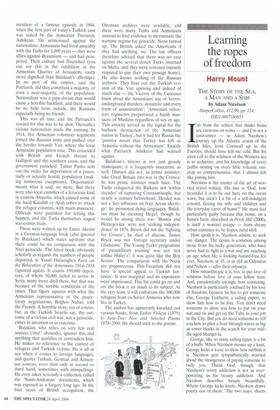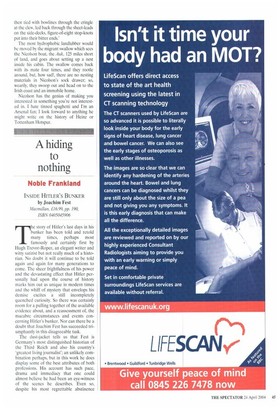Learning the ropes of freedom
Harry Mount
THE STORY OF THE SEA, A MAN AND A SHIP by Adam Nicolson HatperCollins, £12.99, pp. 224, ISBN 0007180853 I'm from the school that thinks boats are caravans on water — and I'm not a caravanner — so Adam Nicolson's journey up the Atlantic coasts of the British Isles, from Cornwall up to the Faeroes, should have left me cold. But his siren call to the wildness of the Western sea is so seductive, and his knowledge of every puffin nesting on every little volcanic outcrop so comprehensive, that I almost felt like joining him. Nicolson is the master of the art of worried travel writing. His line is 'God, how beautiful it is to be out here on the ocean wave, but aren't I a bit of a self-indulgent coward, fleeing my wife and children and the everyday cares of home?' He must feel particularly guilty because that home, on a Sussex farm, described in Perch Hill (2000), is itself a worried escape — from dreary urban existence to, he hopes, rural idyll. How spoilt it is, Nicolson admits, to seek out danger. The desire is common among those from his lucky generation, who have never had to fight in a war and are reaching an age when life is looking hazard-free for ever. Nicolson, at 45, is as old as Odysseus and Nelson — after their odysseys. How misanthropic it is, too, to put love of wildness before love of your fellow man. And, paradoxically enough, how restricting. Nicolson is particularly confined by his love of freedom, because he has to get someone else, George Fairhurst, a sailing expert, to show him how to be free. You don't need someone to show you how to put on your suit and tie and get on the Tube to your job in the City. But you do need someone to tell you how to pilot a boat through waves as big as tower blocks in the search for your middle-aged Shangri-la. George, like so many sailing types, is a bit of a bully. When Nicolson messes up a knot, George kicks it loose to show how rubbish it is. Nicolson gets sympathetically worried about the strangeness of paying someone to bully you. Thank God, though, that Nicolson's worry addiction is not as overpowering as his beauty addiction. And Nicolson describes beauty beautifully. Where George kicks knots, Nicolson draws poetry out of them: The two stays, sheets
then tied with bowlines through the cringle at the clew, led back through the sheet-leads on the side-decks, figure-of-eight stop-knots put into their bitter ends.'
The roost hydrophobic landlubber would be moved by the migrant swallow which sees the Nicolson boat, the Auk, 125 miles short of land, and goes about setting up a nest inside his cabin. The swallow comes back with its mate four times, and they rootle around, but, how sad!, there are no nesting materials in Nieolson's sock drawer; so, wearily, they swoop out and head on to the Irish coast and an immobile home.
Nicolson has the genius of making you interested in something you're not interested in, I hate tinned spaghetti and I'm an Arsenal fan; I look forward to anything he might write on the history of Heinz or Tottenham Hotspur.



















































































 Previous page
Previous page